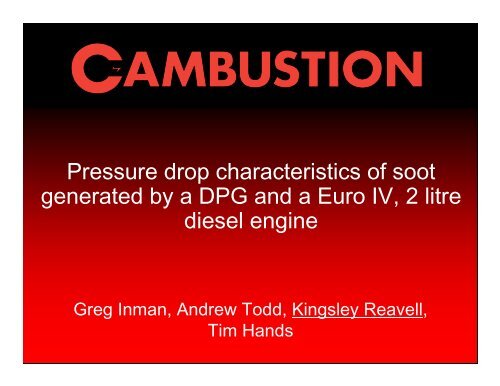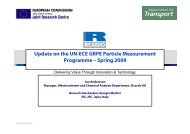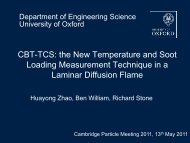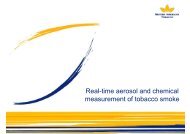Pressure drop characteristics of soot generated by a DPG and a ...
Pressure drop characteristics of soot generated by a DPG and a ...
Pressure drop characteristics of soot generated by a DPG and a ...
Create successful ePaper yourself
Turn your PDF publications into a flip-book with our unique Google optimized e-Paper software.
<strong>Pressure</strong> <strong>drop</strong> <strong>characteristics</strong> <strong>of</strong> <strong>soot</strong><strong>generated</strong> <strong>by</strong> a <strong>DPG</strong> <strong>and</strong> a Euro IV, 2 litrediesel engineGreg Inman, Andrew Todd, Kingsley Reavell,Tim H<strong>and</strong>s
Introduction The <strong>DPG</strong> is part <strong>of</strong> the Cambustion DPF Testing System which tests DieselParticulate Filters for– Backpressure vs <strong>soot</strong> load– Regeneration <strong>characteristics</strong>– Filtration efficiency (with a <strong>soot</strong> monitoring system) This is done <strong>by</strong> loading filters with <strong>soot</strong> <strong>generated</strong> in a Diesel burner, atflows <strong>and</strong> temperatures similar to engine conditions. This work compares the backpressure produced <strong>by</strong> the <strong>soot</strong> from the <strong>DPG</strong>burner with that from <strong>and</strong> engine. Effects causing variability in the backpressure associated with– Engine cold starts– High flow conditionswere measured in these tests <strong>and</strong> are discussed.2
The Cambustion <strong>DPG</strong> More repeatable <strong>and</strong> rapid testing <strong>of</strong> <strong>DPG</strong>s than engine tests Burner conditions unaffected <strong>by</strong> DPF backpressure Automated, unattended testing except for loading & weighing the filter.3
4<strong>DPG</strong> Schematic
<strong>DPG</strong> Flow – Temperature CapabilitySt<strong>and</strong>ard LD version<strong>DPG</strong> - LD Operating Temperature : Flow Rate Capability800700regener ationmode600DPF in let temperature º C500400300200max imum syst em loading capabilit yst<strong>and</strong>ard loadingconditions100burner <strong>of</strong>f condit ions00 100 200 300 400 500 600 700 800 900DPF flow kg / hr5
<strong>DPG</strong> Flow – Temperature CapabilityNew MD Version<strong>DPG</strong> - Medium Duty Operating Temperature : Flow Rate Capability800700DPF inlet temperature ºC600500400300200regen / warm upmax possibleloading limitsIncreased fuel flow: approximately doubled loading ®eneration flowstypical loading setpoint100burner <strong>of</strong>f conditions00 100 200 300 400 500 600 700 800 900DPF flow kg/ hr6
<strong>DPG</strong> Application for Dp vs Soot Mass TestingInstrument : instrument repeatability90802 parts, nominally identical are clearly distinguished on all instruments.Uncoated 2.8 l SiC filters70Backpressure mbar60504030part 1part 22010pore filling <strong>and</strong> cake formation behaviour clearly quantified00 2 4 6 8 10 12 14 16Corrected <strong>soot</strong> mass (g)7
<strong>DPG</strong> Flow Sweep Testing504540Blown Bench Measurements<strong>DPG</strong> measurements at 50 CBackpressure mbar3530252015<strong>DPG</strong> measurements ambient temp10500 100 200 300 400 500 600 700Flow rate m3n/hr <strong>DPG</strong> measures backpressure vs flow up to ~ 600 m 3 /h For comparison with engine results, Reynolds number should be the same– Cold flow test at a lower flow rate than the engine!– This keeps the balance <strong>of</strong> viscous & inertial pressure <strong>drop</strong>s the same.8
Previous Engine Correlation WorkT H<strong>and</strong>s et al, DEER 2007:<strong>Pressure</strong> <strong>drop</strong> vs <strong>soot</strong> load for Engine <strong>soot</strong>s compared with <strong>DPG</strong> <strong>soot</strong>100Transient CycleHigh Load Steady State<strong>DPG</strong>80Normalised <strong>Pressure</strong> <strong>drop</strong>60402000 5 10 15 20 25 30 35Total Soot (g)9 Difference between cycle & steady state engine <strong>soot</strong> Engine <strong>soot</strong> backpressure measured on engine: less accurate Other private data also shows significant variation between engines
New Test Programme DPF canned for easy connection to engine Load on engine or <strong>DPG</strong>. Cold flow test at 0g, 5g, 15g, 20g & 30g on <strong>DPG</strong>– Improved accuracy compared with engine backpressure measurementdue to accurate & stable temperature <strong>and</strong> flow Original plan:regenwarmup0gweighflow testload5gweighflow testload15gweighflow testload20gweighflow testload30gweighflow test10Engine / <strong>DPG</strong><strong>DPG</strong>
Engine Details 2l Common rail Diesel engine Stage 4 emissions compliant Mounted on dynamic dyno– Comparisons made with cycle <strong>soot</strong> Fitted with Diesel Oxidation Catalyst upstream <strong>of</strong> DPF– In this test programme, the <strong>DPG</strong> testing was not fitted with the DOC. This is tosimulate best the application <strong>of</strong> the <strong>DPG</strong> for testing filters which are then usedwith an upstream DOC, currently the majority application.– For single brick systems, the engine <strong>soot</strong> would differ mainly via higher levels <strong>of</strong>volatile components. All tests performed on the same DPF:– 5.66” dia x 10” 4.1 l– Uncatalysed SiC.11
Soot Loading Conditions Engine – 3 conditions used– NEDC – approx 3g/h for this engine– ‘Rural’ drive cycle – 6g/h– Steady state accelerated <strong>soot</strong> loading (modified engine operating points) – 10g/h <strong>DPG</strong>– All tests at approx 10 g/h setpoint12
Effect 1: Backpressure ‘Relaxation’ in flow test27g load908070Flow test sweeps flow up <strong>and</strong> then down.First flow test shows reduced pressure on downsweep60504030201000 50 100 150 200 250 300 350 400Equivalent flow (m3/hr)first flow testrepeatfirst flowtesttestFurther repeats then stable up <strong>and</strong> down same trajectoryShape closer to expected quadratic13
High Flow Relaxation Conclusions Deposited <strong>soot</strong> is disturbed <strong>by</strong> high flow conditions Once relaxation has occurred, <strong>soot</strong> is then stable. Flow tests all repeated twice in this work, <strong>and</strong> data quoted from repeat.14
Backpressure reduction in multistage loading (1)120100Equivalent delta p @ 300m3/hour (mbar)806040Accelerated <strong>soot</strong> loadLoaded to 14.3g <strong>and</strong> then on to 19.7gBackpressure lower at 19.7g than 14.3!2000 5 10 15 20 25Soot load (g)15
Backpressure Reduction In multistage loading (2)1009080<strong>Pressure</strong> <strong>drop</strong> at 300m³/hr (mbar)7060504030Loaded <strong>and</strong> flowtested same dayPart loaded <strong>and</strong>topped up from cold,then flow testedSS Engine <strong>soot</strong>loads201000 5 10 15 20 25 30 35Sootload (g)16
<strong>DPG</strong> <strong>soot</strong> subjected to cold start on engine10090Flow test80Load on <strong>DPG</strong><strong>Pressure</strong> <strong>drop</strong> at 300m³/hr (mbar)7060504030Flow testEngine cold startFlow testLoad on <strong>DPG</strong>Flow test<strong>DPG</strong> <strong>soot</strong>loads20Engine cold start10Flow test00 5 10 15 20 25 30 35Sootload (g)17
Cold Restart Backpressure Reduction16016maf_kgh_mes140DPF Indelta pMAF constant1412012MAF (kg/hr), Temperature (°C)1008060Engine StartedSpeed increasedto 2000rpm<strong>Pressure</strong> <strong>drop</strong> decreasing1086dP (mbar)404202Dry gas enetering DPF 'Wet' gas entering DPF (Condensate heating)0030 35 40 45 50 55 60 65 70Time (s)18
Recovery <strong>of</strong> Reduced Backpressure160140120Part loaded to 17g on <strong>DPG</strong>Cold start on EngineLoading continued to 29.5gCompared with continuous load to 29g1008060402000 5 10 15 20 25 30DPF dP corr DPF dP corr DPF dP corr19
Effect <strong>of</strong> Cold Start - summary Regardless <strong>of</strong> <strong>soot</strong> type, engine cold start appears to cause reduction inbackpressure Does not occur with restart in loading on <strong>DPG</strong> Reduction in backpressure is visible in real time during engine start Possibly connected with condensation & re-evaporation <strong>of</strong> water from <strong>soot</strong>cake, damaging the structure. Reduction in backpressure not fully recovered with further loading. All engine loaded data in the comparison is therefore loaded directly fromzero to the final weight.– Significant increase in the amount <strong>of</strong> testing required.20
Backpressure vs Soot Load Engine & <strong>DPG</strong>120100NEDC Soot (3g/hr)Accelerated Steady State Soot (10g/hr)Rural Drivecycle Soot (6g/hr)<strong>DPG</strong> Soot (10g/hr)EmptyCoated DPF <strong>DPG</strong> Soot (10g/hr)<strong>Pressure</strong> <strong>drop</strong> at 300m³/hr (mbar)80604020All cycles produce effectively identicalbackpressure<strong>DPG</strong> also the same, except for possible slightincrease at very high loads00 5 10 15 20 25 30 35Sootload (g)21
Conclusions Significant effects on backpressure measurement noted in this work:– Relaxation <strong>of</strong> <strong>soot</strong> at high flow rates– Permanent reduction in backpressure <strong>by</strong> engine cold start With these effects avoided, all engine cycles produced very similarbackpressure vs <strong>soot</strong> load. <strong>DPG</strong> <strong>soot</strong> also behaves the same as engine <strong>soot</strong>. Inconsistent with earlier experience– Previous tests did not carefully avoid effects above– Increased variability in engine rather than <strong>DPG</strong> tests– Different behaviour <strong>of</strong> different engines.22
Further Work There is scope for further work:– Variation in <strong>soot</strong> behaviour between different engines.– Effect <strong>of</strong> different filter types (catalysed, materials)– Investigation <strong>of</strong> effects at very high loads– Comparison <strong>of</strong> regeneration behaviour <strong>of</strong> engine & <strong>DPG</strong> <strong>soot</strong> – ongoing.23
AcknowledgementsThanks to all the coauthors who did more <strong>of</strong> this work than me, <strong>and</strong> alsoRay Br<strong>and</strong> <strong>and</strong> Jason Sumner who did most <strong>of</strong> the testing.24





